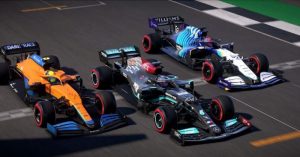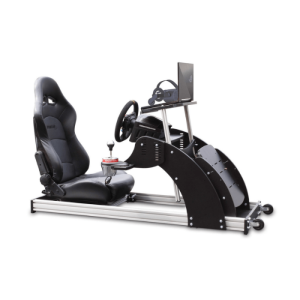
Ever wondered what separates the heart-pounding, physics-defying thrills of arcade racing from the meticulous precision of simulation? This isn’t just about fancy graphics; it’s a clash of philosophies, targeting different players and demanding different skill sets. We’ll explore the core mechanics, the target audiences, and even the monetization strategies that make these two racing subgenres so distinct. Buckle up, because this ride is going to be fast-paced and insightful!
From the subtle nuances of tire physics in a sim racer to the over-the-top stunts of an arcade title, we’ll dissect the design choices, development challenges, and the overall player experience. We’ll examine successful examples of each genre, explore the role of online multiplayer, and even delve into the ethical considerations surrounding in-app purchases and gambling integration. Get ready to discover the fascinating world of racing game development!
Target Audience and Player Experience
Simulation and arcade racing games cater to vastly different player preferences and skill levels, resulting in distinct experiences. Understanding these differences is crucial for both developers and players to find the right fit. This section will explore the ideal player profiles, required commitment, and overall enjoyment derived from each genre.
Ideal Player Profiles
The ideal player for a simulation racing game possesses a high level of patience and a dedication to mastering realistic driving techniques. They are often drawn to the challenge of precise control and the rewarding feeling of achieving a perfect lap. Think of someone who enjoys the intricate details of car setup, tire management, and fuel strategy. Conversely, the ideal arcade racer seeks immediate gratification and exhilarating speed.
They value fun, accessible gameplay over realistic physics and are less concerned with minute details. This player type prioritizes quick races and exciting stunts over meticulously planned maneuvers. Imagine someone who enjoys pick-up-and-play games and thrilling, over-the-top action.
Skill and Commitment Levels
Simulation racing demands significant skill and a substantial time commitment. Players need to learn complex driving techniques, understand car physics, and master the nuances of different tracks. Hours of practice are often required to achieve proficiency, and continuous learning is essential to stay competitive. Examples include mastering braking points, apexing corners precisely, and managing tire wear across a race.
In contrast, arcade racing games have a much lower barrier to entry. Basic skills are quickly learned, and players can enjoy the game without extensive practice. While skill improvement is possible, the core gameplay remains accessible and forgiving, allowing for quick enjoyment. Think of the immediate satisfaction of drifting around corners or pulling off a spectacular jump in an arcade racer versus the long-term commitment needed to master a difficult track in a simulation game.
Player Experience: Enjoyment and Satisfaction
The overall player experience differs greatly between the two genres. Simulation racing offers a deep sense of accomplishment and satisfaction from mastering challenging tracks and outsmarting opponents through strategic driving. The reward comes from precision, skill, and meticulous planning. Imagine the feeling of setting a personal best lap time after hours of practice. Conversely, arcade racing delivers instant gratification and thrilling moments of excitement.
The focus is on fun, fast-paced action, and spectacular stunts. The satisfaction comes from the adrenaline rush and the sheer enjoyment of the ride. Consider the exhilaration of a perfectly executed drift or a nail-biting finish in a close race. Ultimately, both genres offer unique forms of enjoyment, appealing to different player preferences and expectations.
Game Design and Development Aspects

Blending simulation and arcade racing presents a unique challenge in game design, demanding a careful balance between realism and accessibility. The goal is to create a game that appeals to both hardcore sim racers seeking authentic driving experiences and casual players looking for fun and fast-paced action. This requires thoughtful consideration of physics, handling, and overall game mechanics.A fictional racing game concept, tentatively titled “Velocity Shift,” aims to achieve this balance.
It features a diverse roster of cars, ranging from meticulously modeled classic muscle cars to futuristic hypercars, each with unique handling characteristics influenced by real-world counterparts but tweaked for satisfying arcade-style responsiveness.
Realistic Racing Physics Implementation
Developing realistic racing physics is a complex undertaking, demanding a deep understanding of vehicle dynamics, tire models, and surface interactions. The challenge lies in accurately simulating forces like gravity, friction, and aerodynamic drag, while simultaneously optimizing performance to maintain smooth gameplay, even with numerous vehicles on screen. Factors such as tire deformation, suspension geometry, and center of gravity significantly influence a car’s handling, and their accurate representation is key.
A common approach is to utilize sophisticated physics engines like PhysX or custom-built solutions, often requiring extensive testing and iterative refinement to achieve a balance between realism and playability. The process often involves simplifying complex real-world phenomena while retaining a sense of authenticity. For instance, a simplified tire model might capture the essential characteristics of grip and slip, rather than modeling every microscopic interaction between tire and road surface.
Examples of Successful Hybrid Racing Games
Several successful racing games have effectively balanced simulation and arcade elements. Forza Horizon series expertly blends the freedom of open-world exploration with satisfying driving mechanics that cater to a broad spectrum of players. The series’ accessible controls and forgiving physics allow casual players to enjoy the game’s beautiful landscapes and varied gameplay, while detailed car tuning and challenging races provide a more rewarding experience for simulation enthusiasts.
Similarly, the Gran Turismo series, while leaning more towards simulation, offers various driving assists and difficulty settings that allow players of different skill levels to enjoy the realistic driving experience. The success of these titles stems from their ability to provide depth and complexity for seasoned players while maintaining accessibility for newcomers. The careful tuning of physics and the provision of various game modes cater to different preferences, leading to broad appeal and lasting success.
Monetization Strategies in Racing Games
The world of racing games, encompassing both the realistic simulation and the adrenaline-pumping arcade styles, presents unique challenges and opportunities for monetization. The key lies in understanding the different player expectations and balancing revenue generation with a positive player experience. A poorly implemented monetization strategy can quickly alienate players, while a well-executed one can ensure the game’s long-term success and sustainability.
Monetization Strategy Comparison: Simulation vs. Arcade Racing
This table compares common monetization strategies for simulation and arcade racing games, highlighting their advantages and disadvantages. The choice of strategy often depends on the target audience, the game’s features, and the overall development budget.
| Game Type | Monetization Method | Pros | Cons |
|---|---|---|---|
| Simulation Racing | Premium Model (One-time purchase) | High initial revenue, strong player loyalty, less intrusive gameplay | Lower player base due to higher upfront cost, limited recurring revenue |
| Simulation Racing | DLC (Downloadable Content) | Provides ongoing revenue streams, expands game content, caters to specific player preferences | Requires consistent content updates, potential for player dissatisfaction if DLC feels overpriced or unnecessary |
| Arcade Racing | Freemium Model (Free-to-play with in-app purchases) | Wide player reach, potential for high revenue through microtransactions, ability to test different monetization strategies | Risk of alienating players with aggressive monetization, potential for pay-to-win scenarios, challenges in balancing free and paid content |
| Arcade Racing | In-Game Advertising | Relatively low development effort, passive revenue generation | Can be intrusive to the player experience, lower revenue per player compared to other methods |
Successful In-App Purchase Models
Successful in-app purchase models require careful consideration of player psychology and game mechanics. For simulation racing games, offering expansion packs with new tracks, cars, or customization options has proven effective. Examples include the various DLC packs released for titles like “Assetto Corsa Competizione,” which provide substantial new content without disrupting the core gameplay experience. These expansions often appeal to dedicated players willing to invest further in a game they already enjoy.For arcade racing games, the freemium model often involves selling virtual currency, cosmetic items (car skins, decals), and performance boosts.
“Asphalt 9: Legends” exemplifies this approach successfully. The game is free to play, but players can purchase premium currency to unlock new cars more quickly or acquire special cosmetic items. The key to success here is to offer a compelling free-to-play experience that doesn’t feel excessively restrictive, encouraging players to spend money on enhancements rather than feeling forced to do so.
Ethical Considerations of Microtransactions
The ethical implementation of microtransactions is paramount. Pay-to-win mechanics, where players can significantly outperform others simply by spending money, are widely criticized and can damage a game’s reputation. Transparency is crucial; players should clearly understand what they are paying for and how it affects gameplay. Offering a fair and balanced experience, where skill and strategic play remain significant factors, is vital for maintaining player trust and enjoyment.
The use of loot boxes, which often involve randomized rewards, also raises ethical concerns due to their potential for addictive behavior and exploitation. Responsible developers strive to avoid these practices and focus on monetization methods that enhance the game experience without creating unfair advantages or manipulative tactics.
The Role of Online Multiplayer

Online multiplayer fundamentally alters the racing game experience, transforming a solitary pursuit into a dynamic social competition. The impact differs significantly between simulation and arcade racers, shaping not only gameplay but also the overall community culture.The addition of online multiplayer introduces a competitive element that intensifies the core gameplay loop. In simulation racing, this manifests as intense battles for track position, strategic overtaking maneuvers, and the pressure of maintaining consistent performance against skilled opponents.
Arcade racers, on the other hand, often emphasize chaotic fun and aggressive driving, leading to more unpredictable and action-packed online sessions. The different focuses shape the design choices, with simulation games prioritizing realistic physics and handling models while arcade titles focus on accessible controls and over-the-top stunts.
Competitive Landscapes of Online Simulation and Arcade Racing Communities
Simulation and arcade racing communities exhibit distinct characteristics. Simulation racing fosters a more mature and strategic competitive environment. Players often engage in organized leagues, participate in esports events, and meticulously analyze their performance data. Communication and teamwork are crucial in online races, particularly in endurance events. The focus is on mastering the technical aspects of driving, understanding car setup, and executing clean racing lines.
In contrast, arcade racing communities tend to be more casual and less focused on strict rules. The emphasis is on fun, high-octane action, and quick, exciting races. While competition exists, the atmosphere is often less serious and more accepting of aggressive driving tactics. Think of the difference between a Formula 1 team’s meticulous preparation and a group of friends racing go-karts – both are competitive, but the approach and culture are vastly different.
Designing Online Leaderboards and Rankings for Diverse Player Bases
A successful online leaderboard system needs to cater to the diverse skill levels and playstyles found within both simulation and arcade racing communities. A simple solution would be to create separate leaderboards for each game mode. This would allow for a more accurate representation of player skill within their specific genre. For example, a simulation game could have separate leaderboards for different car classes or tracks, while an arcade game could have leaderboards based on game modes or specific challenges.
Further refinement could involve a tiered ranking system within each leaderboard, using a system similar to ELO rating, where players gain or lose points based on the skill level of their opponents. This dynamic system would continuously adapt to the player’s skill and provide a more accurate reflection of their performance compared to a static system solely based on race wins.
Additionally, the system could incorporate different metrics beyond simple win rates. For simulation games, this might include lap times, consistency metrics, and even race craft evaluations. Arcade games might prioritize points scored, stunts performed, or total distance traveled. This approach provides a more comprehensive and nuanced view of player performance, making the leaderboards more engaging and fair for a wide range of players.
Expanding into Related Game Genres
The success of online racing games hinges on a sophisticated blend of factors, from realistic physics engines to engaging multiplayer experiences. Understanding the overlap between online game development in general and the nuances of driving and racing games is crucial for expanding into related genres and leveraging existing expertise. This exploration will highlight the commonalities and unique challenges presented by different game types, specifically focusing on bike games and comparing the development of online car racing games to other online genres.The development of online games, regardless of genre, shares core elements such as robust server infrastructure, networking protocols, and player account management.
However, the specific demands vary greatly. Racing games, for example, demand highly optimized physics engines capable of handling complex vehicle interactions and real-time collision detection. This contrasts sharply with a card game, where the core mechanics are significantly less computationally intensive.
Online Game Development and Racing Games: Shared Principles
Online game development, whether for racing or other genres, necessitates a robust understanding of network programming, database management, and security protocols. Both racing and other online games rely on efficient server architectures to handle concurrent player interactions and maintain a seamless experience. Furthermore, features like in-game chat, leaderboards, and friend systems are common across numerous online game genres, requiring similar development approaches in terms of user interface design and backend integration.
The key difference lies in the core gameplay mechanics. Racing games require real-time physics simulations and precise control inputs, demanding significant computational power and optimization, unlike turn-based games or strategy games.
Design Considerations for Bike Racing Games
Bike racing games present a unique set of design challenges compared to car racing games. The two-wheeled nature of motorcycles introduces a higher degree of instability and sensitivity to player input. This requires a physics engine capable of accurately simulating factors like leaning, weight transfer, and wheel slippage. Game mechanics must account for the increased difficulty of controlling a motorcycle, potentially requiring more forgiving handling or advanced assistance systems for novice players.
Visual design also plays a crucial role, with the need to accurately depict the rider’s movements and interactions with the bike, adding complexity to character animation. Consider the popular “TT Isle of Man” series; its success hinges on accurately simulating the challenging course and the physics of high-speed motorcycle racing, demanding a high level of precision in its development.
Development Challenges: Car Racing vs. Card Games
Developing online car racing games presents significantly different challenges compared to genres like online card games. The real-time nature of racing games demands low latency and high bandwidth to ensure smooth gameplay. This necessitates careful server architecture design and optimization, particularly concerning collision detection and physics calculations. In contrast, card games typically involve turn-based gameplay with less demanding real-time requirements, allowing for simpler server architectures and potentially wider accessibility on less powerful hardware.
Furthermore, the visual fidelity and physics simulation in racing games are significantly more complex than those in card games, leading to higher development costs and longer production cycles. The development of “Forza Horizon 5,” for example, required a massive team and extensive resources to achieve its level of visual realism and detailed physics engine. This contrasts sharply with the development of a simple online card game like “Solitaire,” which can be developed with far fewer resources.
Gambling Integration (Ethical Considerations)
The integration of gambling mechanics into racing games presents a complex ethical landscape, demanding careful consideration of potential harms and benefits. While the allure of virtual currency and in-game betting can enhance engagement, it also carries the risk of addiction and exploitation, particularly among vulnerable players. Balancing the potential for increased revenue with the responsibility of protecting players requires a nuanced approach.The ethical implications of incorporating gambling elements into racing games are multifaceted.
Concerns exist regarding the potential for problem gambling, the targeting of vulnerable populations (children and adolescents, particularly), and the normalization of gambling behavior. Furthermore, the design of these mechanics can significantly influence player behavior, making it crucial to implement responsible gambling features and robust safeguards. The potential for financial exploitation, particularly through predatory microtransactions, is a significant ethical concern.
Regulatory Landscape of Online Gambling
The regulatory landscape surrounding online gambling varies considerably across jurisdictions. Many countries have established gambling commissions or similar regulatory bodies responsible for licensing and overseeing online gambling operators. These commissions set standards for responsible gambling practices, including age verification, deposit limits, and self-exclusion options. The absence of consistent global regulations, however, creates challenges in ensuring player protection across international borders.
For example, the UK Gambling Commission operates under strict guidelines, requiring rigorous player protection measures, while other regions may have less stringent rules or even permit unregulated gambling platforms. This disparity necessitates a careful assessment of legal requirements before integrating gambling features into a racing game, ensuring compliance with all relevant laws and regulations in each target market.
Case Study: “Velocity Rush” and Gambling Integration
Let’s consider a hypothetical racing game, “Velocity Rush,” initially designed without gambling mechanics. Its player base enjoys the core racing experience, with a substantial number of active players and positive community engagement. The developers then introduce a system of gambling chips earned through gameplay, which can be used to bet on races or purchase cosmetic items through a loot box system.
Initially, the integration boosts engagement and revenue. However, anecdotal evidence begins to emerge of players spending excessive amounts of money on gambling chips, neglecting their real-world responsibilities. Furthermore, a significant portion of new players are drawn in by the gambling aspect, but many exhibit patterns consistent with problem gambling behavior. The game’s previously positive community becomes increasingly fractured, with complaints about unfair odds and the prevalence of gambling-related issues.
This hypothetical scenario highlights the potential for negative consequences, including reputational damage, legal repercussions, and a decline in the overall player experience. The “Velocity Rush” case study demonstrates that while gambling integration might initially seem lucrative, it carries considerable risks if not implemented responsibly and ethically. A thorough risk assessment and robust mitigation strategies are essential before considering such integration.
The Influence of Location and Culture
The global video game industry, particularly the racing and gambling sectors, is profoundly shaped by the unique cultural landscapes and regulatory environments of different regions. Location significantly influences game development, design choices, and ultimately, player experience. Understanding these influences is crucial for creating successful and culturally sensitive games.The interplay between location, culture, and the design of racing and gambling games is complex and multifaceted.
This section will explore how specific geographic locations with established gaming or gambling industries impact game development, how cultural preferences affect online gambling game design and distribution, and how different cultural contexts shape the player experience in online racing games.
Cities Known for Gaming and Gambling and Their Influence on Game Development
Several cities globally are renowned for their significant contributions to the gaming and gambling industries. These locations often serve as hubs for game development studios, attract significant investment, and foster a culture of innovation that shapes the games produced. The concentration of talent and resources in these areas leads to specialized expertise and the development of cutting-edge technologies.
- Las Vegas, Nevada, USA: Known as the “Entertainment Capital of the World,” Las Vegas has profoundly influenced the development of casino-style games and the integration of gambling mechanics into other genres, including racing games. The city’s focus on spectacle and high-stakes entertainment directly translates into game design, emphasizing visually impressive graphics, exciting sound design, and the pursuit of big wins.
- London, England: A major center for both game development and online gambling regulation, London’s influence is felt in the design of online racing games that comply with strict UK regulations, often prioritizing responsible gaming features and robust player protection measures.
- Tokyo, Japan: With a rich history of arcade gaming and a sophisticated understanding of player preferences, Tokyo has shaped the development of racing games with unique aesthetics, gameplay mechanics, and a strong emphasis on community engagement. The influence of Japanese culture is often visible in the art style and narrative elements of games originating from or heavily influenced by Tokyo.
- Seoul, South Korea: Known for its thriving esports scene and sophisticated online gaming infrastructure, Seoul has contributed to the development of competitive online racing games with advanced networking capabilities and a strong focus on e-sports features, including spectator modes and tournament integration.
Cultural Preferences and Regional Regulations Impacting Online Gambling Game Design and Distribution
Cultural norms and government regulations significantly influence the design and distribution of online gambling games. These factors dictate acceptable themes, game mechanics, and the level of player protection required.
For example, certain cultures might have a higher tolerance for risk and gambling, leading to the creation of games with higher volatility and larger potential payouts. Conversely, stricter regulations in other regions may mandate features like deposit limits, self-exclusion options, and responsible gambling tools to mitigate potential harms. Game developers must adapt their designs and marketing strategies to comply with these varying regulations and cultural preferences to ensure legal and ethical operation.
Cultural Contexts Shaping Player Experience in Online Racing Games
The player experience in online racing games is shaped by diverse cultural contexts. This manifests in various ways, including the preferred racing styles, the types of cars and tracks that resonate with players, and the social aspects of gameplay.
For instance, players from regions with a strong car culture might prefer realistic simulations with detailed car customization options, while players from regions with different transportation preferences might find more enjoyment in more arcade-style racing experiences. Similarly, cultural differences can influence the level of competitiveness and the importance of social interaction within online racing communities. Developers must carefully consider these factors to create games that appeal to a broad international audience while respecting and celebrating cultural diversity.
Concluding Remarks
So, Simulation vs. Arcade Racing – it’s not just about choosing between realism and fun, but understanding the fundamental differences in gameplay, player expectations, and even the business models that drive these genres. Ultimately, the best racing game for you depends on your personal preferences and the kind of driving experience you crave. Whether you’re a meticulous driver seeking realistic challenges or a thrill-seeker looking for adrenaline-pumping action, the racing world offers a thrilling game for everyone.
Now go forth and conquer the track!
Popular Questions
What are some examples of popular simulation racing games?
Assetto Corsa Competizione, iRacing, Gran Turismo series, rFactor 2 are all known for their realistic physics and detailed simulations.
What are some examples of popular arcade racing games?
Mario Kart, Need for Speed (most titles), Burnout Paradise, Trackmania offer fast-paced, less realistic, but incredibly fun racing experiences.
Can I use a steering wheel with arcade racing games?
While many arcade games support steering wheels, the experience might not be optimized for the game’s less realistic physics. It’s often more enjoyable using a controller.
Are there racing games that blend simulation and arcade elements?
Yes! Games like Forza Horizon series and Dirt Rally 2.0 successfully blend realistic handling with arcade-style fun and accessibility.






